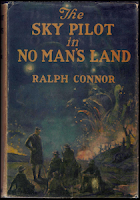Earlier this month, I tried to sell a friend on Basil King, as is my habit. I mentioned that in 1909 his novel The Inner Shrine outsold every other book in the United States, adding that he very nearly repeated that accomplishment the following year, and again the year after that. In this regard, King bested fellow Prince Edward Islander L.M. Montgomery, who never once made the annual top ten.
The annual top ten?
I refer here to lists compiled by The Bookman and Publisher's Weekly. The former cobbled together the first in 1895, the year Scotsman Ian Maclaren's Beside the Bonnie Brier Bush was all the rage. It didn't take long for a Canadian to appear. In 1896, Gilbert Parker's The Seats of the Mighty placed third, blocked from the top spot by Francis Hopkinson Smith's Tom Grogan and A Lady of Quality by Frances Hodgson Burnett, which I'm sure you've all read.
Gilbert Parker – later, Sir Gilbert Parker – was a publisher's dream. Scribner's 1912 twenty-four volume Works of Gilbert Parker is a beautiful thing. The more expensive editions come with a tipped in handwritten autographed letter.
Parker is one of eight Canadians to hit the American year-end top ten. What follows is a year-by-year list of those authors and their titles, beginning with Parker's The Seats of the Mighty. Some may question the inclusion of Saul Bellow and Arthur Hailey. My position on both men is simple. Saul Bellow was born in Lachine, Quebec. He was a nine-year-old when his family left Canada for the United States. Arthur Hailey immigrated to this country after the Second World War and became a Canadian citizen.
Long-time Toronto resident John Irving's The Hotel New Hampshire, which placed second in 1981, is not included because it wasn't until 2019 that he became a Canadian citizen.
W.H. Blake's translation of Louis Hémon's Maria Chapdelain, which in 1922 was the eighth bestselling book in the United States is excluded. Though the novel has been described as a "a classic of French-Canadian literature," Hémon was French, not French-Canadian. His visit to this country lasted months, not years. My late friend Michael Gnarowski argued that Hémon would've become a citizen had he not been struck and killed by a train whilst walking the tracks outside Chapleau, Ontario. On this we disagreed.
1901
#4 – The Right of Way by Gilbert Parker
Two spots down from Parker – at #6 – we find The Visits of Elizabeth, the debut novel by one-time Guelph girl Elinor Glyn.
1902
 #6 – The Right of Way by Gilbert Parker
#6 – The Right of Way by Gilbert Parker
The Weavers again, yet unlike The Right of Way, this one never made Broadway, nor was it adapted by Hollywood.
1909
 #1 – The Inner Shrine by Anonymous [Basil King]
#1 – The Inner Shrine by Anonymous [Basil King]
Reverend King's sixth novel, The Inner Shrine was the year's literary sensation. I think that much of the interest had to do with questions over authorship. Did it come from the pen of Edith Wharton? Henry James? How about the daughter of Willian Dean Howells?
1910

I once described The Wild Olive as the best Basil King novel I'd ever read. Ah, but that was seven years ago and I was so young; The Empty Sack and The Thread of Flame are even better.
One of Connor's Alberta novels, as expected, it was heavily influenced by the Great War. Germans and their country's imperialist aspirations don't come off nearly so well as settlers establishing themselves on the Prairies.
A Great War novel, complete with horrors. The author served as Chaplain in the 43rd Cameron Highlanders. I have more to say on this in an old post on New Canadian Library intros.
The book that launched the longest running series of novels in Canadian history. Sixteen in total!
1928
1931
Interestingly, Finch's Fortune is the third volume in the Jalna saga; Whiteoaks of Jalna, the second, failed to make the year-end top ten.
The last in the series make the year-end top ten, which is not to say that Jalna was abandoned by the reading public. The surprisingly brief de la Roche Canadian Encyclopedia entry reports: "Jalna novels have sold 9 million copies in 193 English- and 92 foreign-language editions."
The Black Rose sold over two million copies. I learned this courtesy of The Canadian Encylopedia's entry on Costain, which is even shorter than de la Roche's!
More anon.
1946
1947
1952
1953
1955
1964
How to explain Herzog's presence? It was awarded the National Book Award, but so had The Adventures of Augie March, and so would Mr. Sammler's Planet, and they didn't make the year-end top ten.
1965
1968
Here the author whose previous novels were set in the hospitalty industry, the aviation industry, the automotive industry, and the banking industry, presents a 512-page novel focussed on a California utility company.
There will be brownouts!
And that's it.
Why is that?
All my theories have fallen flat.
Any ideas?




















































